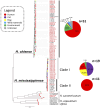Tracing histoplasmosis genomic epidemiology and species occurrence across the USA
- PMID: 38465644
- PMCID: PMC10930103
- DOI: 10.1080/22221751.2024.2315960
Tracing histoplasmosis genomic epidemiology and species occurrence across the USA
Abstract
ABSTRACTHistoplasmosis is an endemic mycosis in North America frequently reported along the Ohio and Mississippi River Valleys, although autochthonous cases occur in non-endemic areas. In the United States, the disease is provoked by two genetically distinct clades of Histoplasma capsulatum sensu lato, Histoplasma mississippiense (Nam1) and H. ohiense (Nam2). To bridge the molecular epidemiological gap, we genotyped 93 Histoplasma isolates (62 novel genomes) including clinical, environmental, and veterinarian samples from a broader geographical range by whole-genome sequencing, followed by evolutionary and species niche modelling analyses. We show that histoplasmosis is caused by two major lineages, H. ohiense and H. mississippiense; with sporadic cases caused by H. suramericanum in California and Texas. While H. ohiense is prevalent in eastern states, H. mississipiense was found to be prevalent in the central and western portions of the United States, but also geographically overlapping in some areas suggesting that these species might co-occur. Species Niche Modelling revealed that H. ohiense thrives in places with warmer and drier conditions, while H. mississippiense is endemic to areas with cooler temperatures and more precipitation. In addition, we predicted multiple areas of secondary contact zones where the two species co-occur, potentially facilitating gene exchange and hybridization. This study provides the most comprehensive understanding of the genomic epidemiology of histoplasmosis in the USA and lays a blueprint for the study of invasive fungal diseases.
Keywords: Histoplasma mississippiense; Histoplasma ohiense; Histoplasmosis; genomics; molecular epidemiology; species distribution modelling.
Conflict of interest statement
No potential conflict of interest was reported by the author(s).
Figures




Similar articles
-
Phenotypic characterization of cryptic species in the fungal pathogen Histoplasma.mSphere. 2024 Jun 25;9(6):e0000924. doi: 10.1128/msphere.00009-24. Epub 2024 May 21. mSphere. 2024. PMID: 38771035 Free PMC article.
-
Biodiverse Histoplasma Species Elicit Distinct Patterns of Pulmonary Inflammation following Sublethal Infection.mSphere. 2020 Aug 26;5(4):e00742-20. doi: 10.1128/mSphere.00742-20. mSphere. 2020. PMID: 32848006 Free PMC article.
-
Phenotypic characterization of cryptic species in the fungal pathogen Histoplasma.bioRxiv [Preprint]. 2024 Jan 8:2024.01.08.574719. doi: 10.1101/2024.01.08.574719. bioRxiv. 2024. Update in: mSphere. 2024 Jun 25;9(6):e0000924. doi: 10.1128/msphere.00009-24. PMID: 38260643 Free PMC article. Updated. Preprint.
-
Histoplasmosis around the world: A global perspective on the presentation, virulence factors, and treatment of histoplasmosis.Am J Med Sci. 2024 Oct;368(4):287-299. doi: 10.1016/j.amjms.2024.06.011. Epub 2024 Jun 15. Am J Med Sci. 2024. PMID: 38885929 Review.
-
Histoplasma mechanisms of pathogenesis--one portfolio doesn't fit all.FEMS Microbiol Lett. 2011 Nov;324(1):1-9. doi: 10.1111/j.1574-6968.2011.02363.x. Epub 2011 Aug 9. FEMS Microbiol Lett. 2011. PMID: 22092757 Free PMC article. Review.
Cited by
-
Histoplasmosis in Taiwan: Case Summary and Literature Review.Life (Basel). 2024 Jun 7;14(6):738. doi: 10.3390/life14060738. Life (Basel). 2024. PMID: 38929720 Free PMC article. Review.
-
Potential predictive value of phylogenetic novelties in clinical fungi, illustrated by Histoplasma.IMA Fungus. 2025 May 23;16:e145658. doi: 10.3897/imafungus.16.145658. eCollection 2025. IMA Fungus. 2025. PMID: 40453382 Free PMC article.
-
Multiple concurrent opportunistic infections in patient with myasthenia gravis: A case report.Virulence. 2025 Dec;16(1):2545570. doi: 10.1080/21505594.2025.2545570. Epub 2025 Aug 28. Virulence. 2025. PMID: 40874431 Free PMC article.
-
High Genetic Diversity of Histoplasma in the Amazon Basin, 2006-2017.Emerg Infect Dis. 2025 Jun;31(6):1169-1177. doi: 10.3201/eid3106.241386. Emerg Infect Dis. 2025. PMID: 40439432 Free PMC article.
-
Phenotypic characterization of cryptic species in the fungal pathogen Histoplasma.mSphere. 2024 Jun 25;9(6):e0000924. doi: 10.1128/msphere.00009-24. Epub 2024 May 21. mSphere. 2024. PMID: 38771035 Free PMC article.
References
-
- Linder KA, Kauffman CA.. Histoplasmosis: epidemiology, diagnosis, and clinical manifestations. Curr Fungal Infect Rep. 2019/09/01;13(3):120–128. doi:10.1007/s12281-019-00341-x - DOI
MeSH terms
Grants and funding
LinkOut - more resources
Full Text Sources
Other Literature Sources
Medical
Miscellaneous
